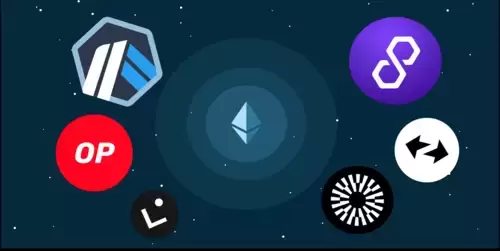 |
|
 |
|
 |
|
 |
|
 |
|
 |
|
 |
|
 |
|
 |
|
 |
|
 |
|
 |
|
 |
|
 |
|
 |
|
지난주에 암호화 공간에서 큰 일이 일어 났지만 소수의 사람들만이 그 중요성을 완전히 이해했습니다.

Last week, something huge happened in crypto, but few realized its full implications. Celo announced its transition from an independent L1 blockchain to an L2 blockchain on Ethereum.
지난주에 암호화에서 큰 일이 일어 났지만 그 전반적인 영향을 깨닫는 사람은 거의 없었습니다. Celo는 독립적 인 L1 블록 체인에서 Ethereum의 L2 블록 체인으로의 전환을 발표했습니다.
This might seem like another tech migration, but it’s a sign of a broader shift that Ethereum has been silently driving, one that’s quickly changing how we view projects in crypto. Let’s break this down further.
이것은 또 다른 기술 마이그레이션처럼 보일지 모르지만, 이더 리움이 조용히 운전하고있는 더 넓은 변화의 신호는 암호화에서 프로젝트를 보는 방식을 빠르게 변화시킵니다. 이것을 더욱 세분화합시다.
1. Industry begins to take cost & revenue issues seriously
1. 산업은 비용 및 수익 문제를 심각하게 취하기 시작합니다.
We are in the midst of a long overdue correction. Crypto markets are beginning to refocus on fundamentals. Narratives still matter, but now people are asking:
우리는 오랫동안 기한이 지난 수정 중입니다. 암호화 시장은 기본에 초점을 맞추기 시작했습니다. 이야기는 여전히 중요하지만 이제 사람들은 다음과 같이 묻습니다.
* What’s the actual revenue of this chain?
*이 체인의 실제 수익은 얼마입니까?
* How much does it cost to operate?
* 운영 비용은 얼마입니까?
* Where does value accumulate?
* 가치는 어디에서 축적됩니까?
A host of new metrics, like market cap to revenue (REV), are coming into play, revealing stark differences between seemingly similar blockchains.
시가 총액에서 수익 (REV)과 같은 새로운 메트릭이 작용하여 비슷한 블록 체인 사이의 뚜렷한 차이를 드러내고 있습니다.
This may be why Celo decided to switch to Ethereum L2.
이것이 Celo가 Ethereum L2로 전환하기로 결정한 이유 일 수 있습니다.
2. L1 cannot generate revenue, but L2 can
2. L1은 수익을 창출 할 수 없지만 L2는 할 수 있습니다
This is often overlooked: L1 chains are not able to generate revenue in a sustainable way.
이것은 종종 간과됩니다. L1 체인은 지속 가능한 방식으로 수익을 창출 할 수 없습니다.
Why? Because all value goes directly to stakers or miners. L1 collects fees, which are immediately distributed as block rewards or staking returns. There is no retained profit margin, no surplus, and no funds are left to fund innovation or protocol development.
왜? 모든 가치는 스테이커 나 광부에게 직접 진행되기 때문입니다. L1은 수수료를 징수하며 즉시 블록 보상 또는 스테이 킹 리턴으로 배포됩니다. 혁신이나 프로토콜 개발에 자금을 지원하기 위해 유지 이익 마진, 잉여금이 없으며 펀드가 남아 있지 않습니다.
This creates a strange situation where L1s can be extremely valuable platforms but still operate like public infrastructure, with no built-in funding mechanisms to enable their development and evolution.
이는 L1이 매우 귀중한 플랫폼이 될 수 있지만 여전히 공공 인프라와 같이 작동하는 이상한 상황을 만듭니다. 개발 및 진화를 가능하게하는 자금 조달 메커니즘이 내장되어 있지 않습니다.
Contrast this with L2, which is able to retain and redeploy revenue. Collator fees, maximum extractable value (MEV), or even custom charges for block space can be retained and reinvested in R&D, developer funding, growth promotion activities, or public goods. This is a model that can achieve true sustainability and align incentives over time.
이것을 L2와 대조하여 수익을 유지하고 재배치 할 수 있습니다. Collator 수수료, 최대 추출 가능한 가치 (MEV) 또는 블록 공간에 대한 사용자 정의 요금은 R & D, 개발자 자금 조달, 성장 촉진 활동 또는 공공재로 보유하고 재투자 할 수 있습니다. 이것은 진정한 지속 가능성을 달성하고 시간이 지남에 따라 인센티브를 조정할 수있는 모델입니다.
This is why so many new ecosystems choose to prioritize building L2. It’s not just about technical architecture, it’s also about economic design.
그렇기 때문에 많은 새로운 생태계가 L2 건물의 우선 순위를 정하는 이유입니다. 기술 아키텍처뿐만 아니라 경제 설계에 관한 것입니다.
3. L1 is the mainframe in the Web3 era
3. L1은 Web3 시대의 메인 프레임입니다
Here’s a simple mental model: L1 blockchains are like mainframes for crypto.
간단한 정신 모델은 다음과 같습니다. L1 블록 체인은 암호화의 메인 프레임과 같습니다.
In the early days of the Internet, if you wanted to run a serious application, you had to buy a mainframe. You had to maintain the hardware, write your own network stack, and be responsible for every aspect of the system’s uptime, security, performance, etc. It was powerful, but expensive.
인터넷 초기에는 심각한 응용 프로그램을 실행하려면 메인 프레임을 구입해야했습니다. 하드웨어를 유지하고 자체 네트워크 스택을 작성하며 시스템의 가동 시간, 보안, 성능 등의 모든 측면에 책임을 져야했습니다. 강력하지만 비싸졌습니다.
Running an L1 blockchain today faces a similar situation. You need your own consensus mechanism, your own set of validators, and your own token incentives to secure the network. It costs you millions of dollars every year to keep the system running and secure.
오늘 L1 블록 체인을 실행하는 것도 비슷한 상황에 직면 해 있습니다. 자신의 합의 메커니즘, 자신의 유효성 검사기 세트 및 네트워크를 보호하기위한 토큰 인센티브가 필요합니다. 시스템을 계속 실행하고 안전하게 유지하는 데 매년 수백만 달러가 소요됩니다.
Taking Celo as an example, they spend 4% to 6% of the total token issuance each year, about 15 to 25 million US dollars per year, just to maintain basic security and normal operation of the system.
CELO를 예로 들어, 시스템의 기본 보안 및 정상적인 운영을 유지하기 위해 매년 총 토큰 발행의 4% ~ 6%를 매년 약 1,500 만 달러를 소비합니다.
This is not uncommon. It’s true for Ethereum and it’s true for Solana. Every independent L1 has to bear this cost. But the key is: this cost does not decrease with scale. If you are a smaller L1 chain, the cost you bear may be overwhelming.
이것은 드문 일이 아닙니다. 이더 리움에게는 사실이며 Solana에게는 사실입니다. 모든 독립적 인 L1은이 비용을 부담해야합니다. 그러나 핵심은 다음과 같습니다.이 비용은 규모에 따라 감소하지 않습니다. 더 작은 L1 체인이라면 곰 비용이 압도적 일 수 있습니다.
4. L2 is like a hosted server: just as powerful, but cheaper
4. L2는 호스팅 서버와 같습니다.
Now imagine that instead of running a mainframe, you switch to a managed server.
이제 메인 프레임을 실행하는 대신 관리 서버로 전환한다고 상상해보십시오.
You still have control over your environment, you can customise how your blockchain runs, and you still have autonomy over execution, but you don’t have to secure the physical equipment yourself, which is what L2 on Ethereum does.
여전히 환경을 통제 할 수 있으며 블록 체인 실행 방식을 사용자 정의 할 수 있으며 여전히 실행에 대한 자율성이 있지만 Ethereum의 L2가 직접 보안 할 필요는 없습니다.
Celo, as L2, will still provide the same user experience. But now, the heavy lifting of security, such as fraud proofs, consensus mechanisms, and finality of the base layer, is handled by Ethereum. The cost of maintaining this chain has dropped significantly.
L2 AS Celo는 여전히 동일한 사용자 경험을 제공합니다. 그러나 이제 사기 증거, 컨센서스 메커니즘 및 기본 계층의 최종성과 같은 보안의 무거운 해제는 이더 리움이 처리합니다. 이 체인을 유지하는 데 드는 비용은 크게 떨어졌습니다.
Instead of $20 million per year in security costs, the costs are now just state storage fees and data availability costs, which can be further reduced through data compression and the use of alternative data availability layers (Celo chose EigenDA).
보안 비용으로 연간 2 천만 달러 대신 비용은 이제 주 스토리지 수수료 및 데이터 가용성 비용 일 뿐이며, 이는 데이터 압축과 대체 데이터 가용성 계층의 사용 (CELO가 Eigenda를 선택)을 통해 더욱 줄어들 수 있습니다.
5. Why this is a strategic masterstroke for Ethereum
5. 왜 이것이 이더 리움의 전략적 마스터 스트로크인가
This isn’t just about Celo; it also means that Ethereum’s long-term strategy is finally starting to fall into place.
이것은 셀로에 관한 것이 아닙니다. 또한 이더 리움의 장기 전략이 마침내 제자리에 들어가기 시작했음을 의미합니다.
Ethereum is no longer seeking to be the “one server to rule them all.” That vision of a single dominant chain has been proven wrong in every era of computing, whether it’s Web1, Web2, and now Web3.
이더 리움은 더 이상“모두를 지배 할 수있는 하나의 서버”가되기를 원하지 않습니다. 단일 지배적 인 체인에 대한 비전은 컴퓨팅의 모든 시대에 Web1, Web2 및 Web3에 관계없이 잘못된 것으로 판명되었습니다.
Instead, Ethereum is becoming a base layer on which other chains can be built, providing security, decentralization, and interoperability as a service.
대신, 이더 리움은 다른 체인을 구축 할 수있는 기본 계층이되어 보안, 탈 중앙화 및 서비스로서 상호 운용성을 제공합니다.
Yes, at first glance this looks like cannibalization. Ethereum is reducing the “premium” of its L1 chain. But in reality, it
그렇습니다. 언뜻보기에 이것은 식인종처럼 보입니다. 이더 리움은 L1 체인의 "프리미엄"을 줄이고 있습니다. 그러나 실제로는
부인 성명:info@kdj.com
제공된 정보는 거래 조언이 아닙니다. kdj.com은 이 기사에 제공된 정보를 기반으로 이루어진 투자에 대해 어떠한 책임도 지지 않습니다. 암호화폐는 변동성이 매우 높으므로 철저한 조사 후 신중하게 투자하는 것이 좋습니다!
본 웹사이트에 사용된 내용이 귀하의 저작권을 침해한다고 판단되는 경우, 즉시 당사(info@kdj.com)로 연락주시면 즉시 삭제하도록 하겠습니다.

























































